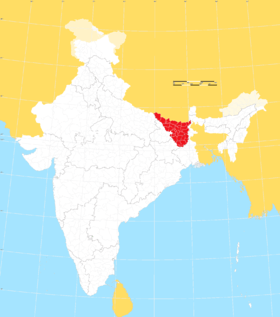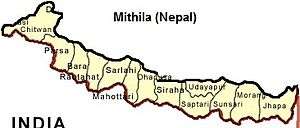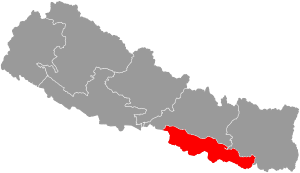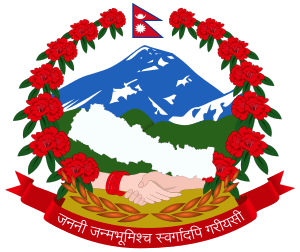Mithila (region)
| Mithila | |
|---|---|
| Region | |
| Continent | Asia |
| Countries | |
Mithila (IAST: mithilā), also known as Tirhut and Tirabhukti, is a geographical and cultural region mainly located in the Indian state of Bihar. This region is bounded by the Mahananda River in the east, the Ganges in the south, the Gandaki River in the west and by the foothills of the Himalayas in the north.[1][2] It extends into the eastern Terai of Nepal.[3][4]
The native language in Mithila is Maithili, and its speakers are referred to as Maithils.[1]
The name Mithila is commonly used to refer to the Videha Kingdom, as well as to the modern-day territories that fall within the ancient boundaries of Videha.[4] In the 18th century, when Mithila was still ruled in part by the Raj Darbhanga, the British Raj annexed the region without recognizing it as a princely state.[5][6] Mithila comprises Tirhut, Darbhanga, Kosi, Purnia, Munger, Bhagalpur and Santhal Pargana divisions[lower-alpha 1] of India[7] and some adjoining districts of Nepal.
History
Vedic period
Mithila first gained prominence after being settled by Indo-Aryan peoples who established the Videha kingdom.[8] During the late Vedic period (c. 1100–500 BCE), Videha became one of the major political and cultural centers of South Asia, along with Kuru and Pañcāla. The kings of the Videha Kingdom were called Janakas.[9] The Videha Kingdom was later incorporated into the Vajji confederacy, which had its capital in the city of Vaishali, which is also in Mithila.[10]
Medieval period
From the 11th century to the 20th century, Mithila was ruled by various indigenous dynasties. The first of these were the Karnatas who were of Parmar Rajput origin, the Oiniwar Dynasty who were Maithil Brahmins and the Khandavalas of Raj Darbhanga who were also Maithil Brahmins. It was during this period that the capital of Mithila was shifted to Darbhanga.[11]
Geography
Mithila is a distinct geographical region with natural boundaries like rivers and hills. It is largely a flat and fertile alluvial plain criss-crossed by numerous rivers which originate from the Himalayas. Due to the flat plains and fertile land Mithila has a rich variety of biotic resources; however, because of frequent floods people could not take full advantage of these resources.[12]
Seven major rivers flow through Mithila: Mahananda, Gandak, Kosi, Bagmati, Kamala, Balan, and the Budhi Gandak.[13] They flow from the Himalayas in the north to the Ganges river in the south. These rivers regularly flood, depositing silt onto the farmlands and sometimes causing death or hardship.
People
Maithili language speakers are referred to as Maithils and they are an Indo-Aryan ethno-linguistic group. There are an estimated 35 million Maithils in India alone. The vast majority of them are Hindu but there is a small Muslim minority.[14]
The people of Mithila can be split into various caste/clan affiliations such as Brahmins, Rajputs, Kayasthas, Ahirs, Kurmis, Koeris, Baniyas and many more.[15]
Notable people
The following are notable residents (past and present) of Mithila region.
- Ramdhari Singh 'Dinkar' was an Indian Hindi poet, essayist, patriot and academic.[16] He was born in present-day Begusarai district of Mithila region of Bihar, India.[17]
- Bindheshwari Prasad Mandal was an Indian parliamentarian and social reformer who served as the chairman of the Second Backward Classes Commission (popularly known as the Mandal Commission)[18][19] from Saharsa district of Mithila region of Bihar, India.[20][21]
- Phanishwar Nath 'Renu', influential writer of modern Hindi literature in the post-Premchand era, born in present-day Araria district of Mithila[22]
- Syed Shahnawaz Hussain, Indian politician, born in Supaul[23][24][25]
- Bhagwat Jha Azad was the Chief Minister of Bihar and a member of Lok Sabha. He was born in Godda district of Mithila region of present-day Jharkhand, India.[26]
Culture
Madhubani art
Madhubani painting/Mithila painting was traditionally created by the women of different communities in Mithila region of India and Nepal. It is named after Madhubani district of Bihar, India which is where it originated.[27] This painting as a form of wall art was practiced widely throughout the region; the more recent development of painting on paper and canvas originated among the villages around Madhubani, and it is these latter developments that may correctly be referred to as Madhubani art.[28]
Demands for administrative units
Proposed Indian state

There is an ongoing movement in the Maithili speaking region of Bihar for a separate Indian state of Mithila. A likely candidate for the capital of the proposed state is Darbhanga, while other potential sites include Muzaffarpur, Purnia, and Begusarai.[29]
Proposed Nepalese province


There is a movement in the Maithili speaking areas of Nepal for a separate province.[30]Province No. 2 was established under the 2015 Constitution, which transformed Nepal into a Federal Democratic Republic, with a total of 7 provinces. Province No. 2 has a Maithili speaking majority and consists most of the Maithili speaking areas of Nepal. It has been demanded by some Mithila activists that Province No. 2 be named 'Mithila Province'.[31]
References
Notes
- 1 2 Jha, M. (1997). "Hindu Kingdoms at contextual level". Anthropology of Ancient Hindu Kingdoms: A Study in Civilizational Perspective. New Delhi: M.D. Publications Pvt. Ltd. pp. 27–42.
- ↑ Mishra, V. (1979). Cultural Heritage of Mithila. Allahabad: Mithila Prakasana. p. 13.
- ↑ Ishii, H. (1993). "Seasons, Rituals and Society: the culture and society of Mithila, the Parbate Hindus and the Newars as seen through a comparison of their annual rites". Senri Ethnological Studies 36: 35–84. Archived from the original on 23 August 2017.
- 1 2 Kumar, D. (2000). "Mithila after the Janakas". The Proceedings of the Indian History Congress 60: 51–59.
- ↑ Singh, U. N. (1986). "The Maithili Language Movement: Successes and Failures". Language Planning: Proceedings of an Institute: 174–201.
- ↑ Jha, M. (1997). "Hindu Kingdoms at textual level". Anthropology of Ancient Hindu Kingdoms: A Study in Civilizational Perspective. New Delhi: M.D. Publications Pvt. Ltd.
- ↑ Jha, Pankaj Kumar (2010). Sushasan Ke Aaine Mein Naya Bihar. Bihar (India): Prabhat Prakashan.
- ↑ Michael Witzel (1989), Tracing the Vedic dialects in Dialectes dans les litteratures Indo-Aryennes ed. Caillat, Paris, pages 13, 17 116–124, 141–143
- ↑ Witzel, M. (1989). "Tracing the Vedic dialects". In Caillat, C. Dialectes dans les litteratures Indo-Aryennes. Paris: Fondation Hugot. pp. 141–143.
- ↑ Hemchandra, R. (1972). Political History of Ancient India. Calcutta: University of Calcutta.
- ↑ "Anthropology of Ancient Hindu Kingdoms: A Study in Civilizational Perspective". pp. 55–56.
- ↑ Thakur, B., Singh, D.P., Jha, T. (2007). "The Folk Culture of Mithila". In Thakur, B.; Pomeroy, G.; Cusack, C.; Thakur, S.K. City, Society, and Planning. Volume 2: Society. pp. 422–446.
- ↑ "Rivers of Bihar | Bihar Articles". Bihar.ws. Archived from the original on 23 July 2012. Retrieved 4 May 2012.
- ↑ James B. Minahan. "Ethnic Groups of South Asia and the Pacific: An Encyclopedia: An Encyclopedia".
- ↑ Makhan Jha. "Anthropology of Ancient Hindu Kingdoms: A Study in Civilizational Perspective". pp. 33–40.
- ↑ Biography and Works Archived 13 July 2006 at the Wayback Machine. anubhuti-hindi.org.
- ↑ "Special Postage Stamps on Linguistic Harmony of India". Latest PIB Releases. Press Information Bureau of the Government of India. September 1999. Archived from the original on 24 October 2008. Retrieved 26 September 2008.
- ↑ Nitish Kumar and the Rise of Bihar. Penguin Books India. 2011-01-01. ISBN 9780670084593.
- ↑ Nitish Kumar and the Rise of Bihar By Arun Sinha page 53
- ↑ Jaffrelot, Christophe (2010-01-01). Religion, Caste, and Politics in India. Primus Books. ISBN 9789380607047.
- ↑ Religion, Caste, and Politics in India By Christophe Jaffrelot page 475
- ↑ Phanishwar Nath 'Renu' Profile Archived 14 October 2007 at the Wayback Machine. Seasoninindia.
- ↑ IANS (10 December 2013). "BJP's Shahnawaz Hussain on IM hit list". Archived from the original on 26 October 2017. Retrieved 26 October 2017 – via Business Standard.
- ↑ "BJP leader Shahnawaz Hussain's impersonator arrested". NDTV.com. Archived from the original on 19 December 2013. Retrieved 26 October 2017.
- ↑ "PM's 'lack' of leadership has made UPA 'sinking ship': BJP". NewIndianExpress.com. Archived from the original on 4 March 2016. Retrieved 26 October 2017.
- ↑ "Archived copy". Archived from the original on 6 October 2011. Retrieved 6 August 2011.
- ↑ "Madhubani Painting". p. 96. Archived from the original on 28 October 2017. Retrieved 20 February 2017.
- ↑ Carolyn Brown Heinz, 2006, "Documenting the Image in Mithila Art," Visual Anthropology Review, Vol. 22, Issue 2, pp. 5-33
- ↑ "Small States Syndrome in India". p. 146. Archived from the original on 17 February 2017. Retrieved 16 February 2017.
- ↑ Burkert, C. (2012). "Defining Maithil Identity". In Gellner, D.; Pfaff-Czarnecka, J.; Whelpton, J. Nationalism and Ethnicity in a Hindu Kingdom: The Politics and Culture of Contemporary Nepal. London, New York: Routledge. pp. 241–273. ISBN 9781136649561. Archived from the original on 20 August 2017.
- ↑ http://kathmandupost.ekantipur.com/printedition/news/2018-05-02/samiti-vows-to-protest-for-mithila-province.html
Bibliography
- Tukol, T. K. (1980). Compendium of Jainism. Dharwad: University of Karnataka.
- Shah, Umakant Premanand (1987). Jaina-Rupa Mandana: Jaina Iconography:, Volume 1. India: Shakti Malik Abhinav Publications. ISBN 81-7017-208-X.
External links
| Wikisource has the text of the 1911 Encyclopædia Britannica article Mithila. |
